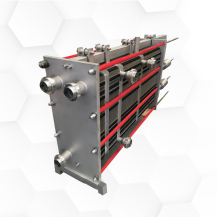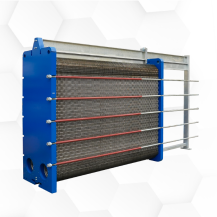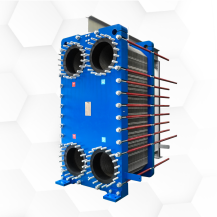How do plate heat exchangers work?
Plate heat exchangers operate based on the principle of heat transfer through a series of thin metal plates. These exchangers consist of multiple plates, which are arranged in a way that creates a series of channels through which hot and cold fluids flow. The hot and cold fluids are separated by the plates, which have a large surface area that allows for efficient heat transfer between the two fluids.
The hot fluid flows through one set of channels, while the cold fluid flows through another set of channels, running parallel to the hot fluid channels. As the fluids flow through the channels, heat is transferred from the hot fluid to the cold fluid through the thin metal plates, resulting in a temperature exchange. The fluid streams are typically counter-flowing, which allows for the most efficient heat transfer.
Advantages of plate heat exchangers
Plate heat exchangers offer numerous advantages over other types of heat exchangers, making them a popular choice for various industrial and commercial applications. Some of the advantages include:
- High efficiency: Plate heat exchangers have a large surface area which enables them to transfer heat more efficiently compared to other types of heat exchangers.
- Compact size: Plate heat exchangers are compact in size and can fit into tight spaces, making them ideal for applications where space is limited.
- Flexible design: The modular design of plate heat exchangers allows for easy customization to fit specific application requirements.
- Easy maintenance: Plate heat exchangers have fewer parts and are easy to disassemble and clean, reducing maintenance time and costs.
- Reduced fouling: The smooth surface of the plates minimizes fouling and reduces the need for cleaning, resulting in longer service life.
- Versatility: Plate heat exchangers can handle a wide range of fluids and can operate under high temperatures and pressures, making them suitable for various industrial applications.
Industries and applications that uses plate heat exchangers
Plate heat exchangers are highly versatile and widely used in various industries and applications for their numerous advantages. Some of the most common industries and applications where plate heat exchangers are used include:
- Heating, Ventilation, and Air Conditioning (HVAC) Industry: Plate heat exchangers are used for heating, cooling, and ventilation systems in buildings and commercial facilities.
- Food and Beverage Industry: Plate heat exchangers are used for pasteurization, sterilization, and cooling of food and beverage products.
- Chemical Industry: Plate heat exchangers are used for heating and cooling of chemicals in various processes, such as distillation, evaporation, and crystallization.
- Oil and Gas Industry: Plate heat exchangers are used for heat transfer in various processes, such as crude oil processing, gas compression, and refinery processes.
- Pharmaceutical Industry: Plate heat exchangers are used for heating and cooling of pharmaceutical products, such as vaccines and drugs, during the manufacturing process.
- Power Generation Industry: Plate heat exchangers are used for heat transfer in various processes, such as cooling of steam and gases in power plants.
- Marine Industry: Plate heat exchangers are used for cooling and heating of various fluids, such as seawater and oil, in marine engines and systems.
Important considerations when selecting plate heat exchangers
When selecting a plate heat exchanger, there are several important considerations to keep in mind:
- Heat transfer requirements: The heat transfer requirements of the application will determine the size and design of the plate heat exchanger needed. Consider factors such as flow rate, temperature, and pressure to ensure the heat exchanger can meet the demands of the application.
- Fluid compatibility: It is crucial to select a plate heat exchanger made from materials that are compatible with the fluids being processed. This will help prevent corrosion, fouling, and other forms of damage.
- Plate design: The design of the plates is another important consideration. Different plate designs offer varying levels of heat transfer efficiency, pressure drop, and resistance to fouling. Consider the nature of the fluid and the operating conditions when choosing the right plate design.
- Cleaning and maintenance requirements: It is important to select a plate heat exchanger that is easy to clean and maintain. Some applications require frequent cleaning or maintenance, so choose a design that can be easily disassembled for cleaning and inspection.
- Energy efficiency: Consider the energy consumption of the plate heat exchanger and select a model that is energy efficient. This will help minimize operating costs and reduce the carbon footprint of the application.
Why buy plate heat exchangers from AxFlow
AxFlow offers plate heat exchangers for the widest range of industries and applications. Only at AxFlow do you receive individual advice from industry-experienced process engineers and the manufacturer-independent selection of the world's leading process technology. Do you need support in selecting the right pump for your needs? Do not hesitate to get in touch. AxFlows experts and engineers can provide guidance for selecting, specifying, installing, and maintaining your fluid handling equipment.








